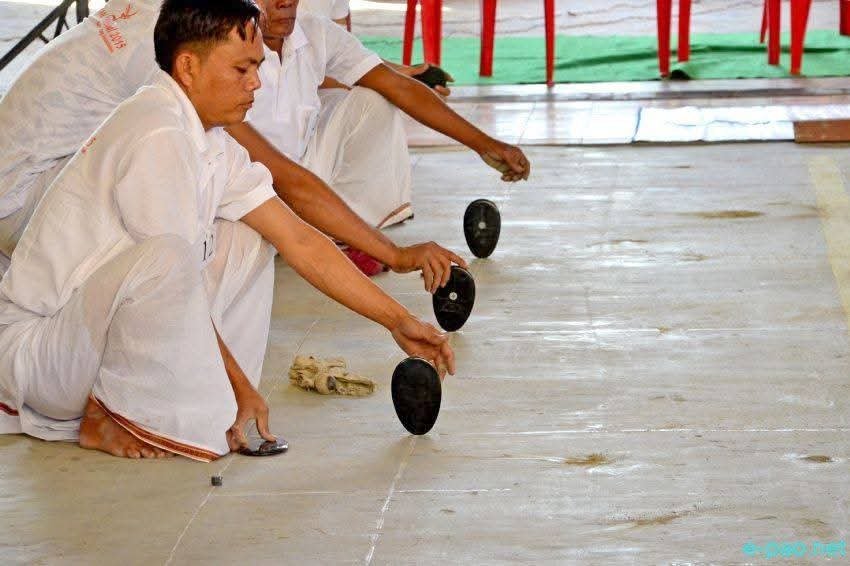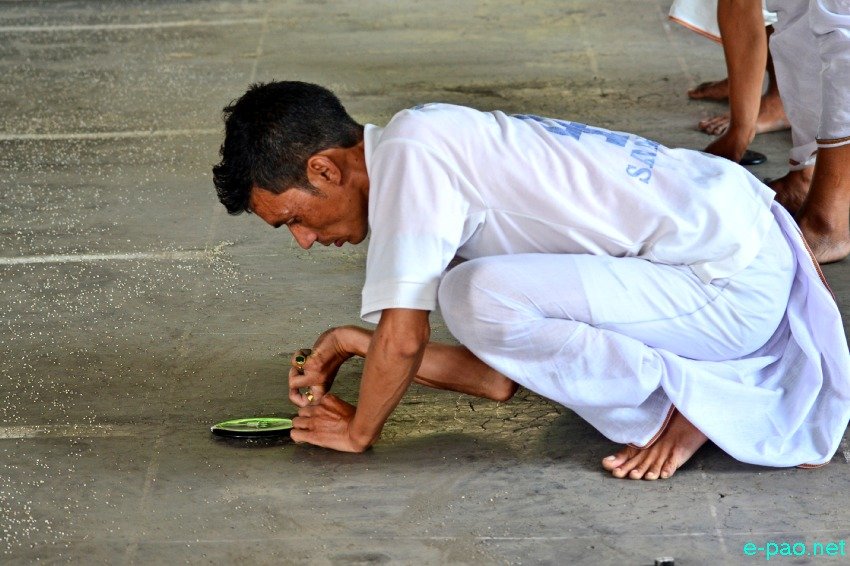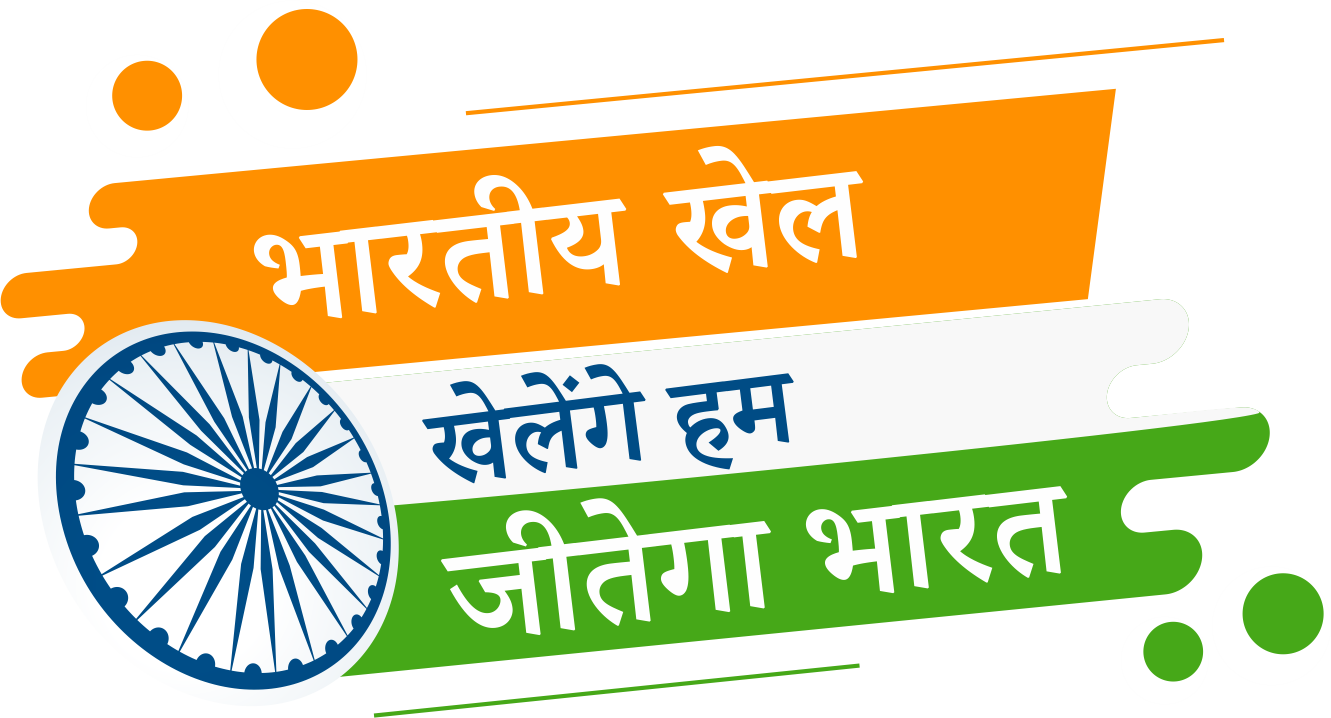Kang Shanaba- Manipur
Introduction
‘Kang Shanaba’ is an indigenous Manipuri game played with Kang – an oval object made of lac or lead with a spot of ivory in the middle.
The Meiteis believe that Kang was originally played by the Seven Lainingthous (deities) and seven Leimarons (female deities) to celebrate the creation of earth and beauty of the rising Sun and Moon. It is derived from the Manipuri word “Kangba” (means to start). The play, therefore, signified the start of a new life after the creation of the earth. Lainingthous and Leimarons played the game seven times, and for seven times the Laimarons won the game.
The latest development is, however, an egg-shaped object made of lac, lad and the like. Kang made of plastic is now becoming very popular.

The Play
The duration of the game will be 4 1/2 hours with an interval of 5 minutes only. After the first half of two hours fifteen minutes the teams will change the sides.
The size of the Kang ‘flat oval object’ should be 5 1/2″ to 6″ in length and 3 1/2″ to 3 3/4″ in breadth. It should be made of lac and should have a fixed face.
Each player should have his own Kang. No two players can use one and the same Kang. Under circumstances, the same Kang is used by two players, it should be done only with the consent of the Referee. No player is allowed to use a Kang which exceeds 16 tolas in weight.
Each team, called a kangkhut, comprises ten players each, including 3 substitutes. The players need a lot of strength and should have proper concentration.
Two teams of seven players each on either side of the play field. A score consists of two Chekpheis and

one “Lamtha”position. As long as one team continues to make scores, the innings will continue. Otherwise, the other team will start their innings and so on. Chekphei is played in standing posture by throwing the Kang to hit the target on the opposite side. Lamtha is shooting the Kang on the surface with a finger to hit the target on the opposite side.
There are separate tracts for each player. A wrong Lamtha, from a player in the concerned track creates complications, resulting in the track becoming “dead” (Shiba).
In the case of two tracks next to the ‘Matais’, after hitting the Kang deflects on the left, this is known as ‘Hanba’ and if it crosses the last boundary in the case of three tracks in the middle, it is known as Hanba and if it doesn’t cross, it is known as Handaba.
The present rules and style of Kang play is an improvement on the old one, played during the time of the Maharajas. To understand the rules, it is necessary to get acquainted with the traditional terms like “Shiba” and “Changba”.
According to our belief, the court in which the Kang is played presents the field of life. The 7(seven) players on each side represents, the 7(seven) days of the week.
For the seven players, there are eigth Chekphei and seven Lamtha Kangkhils. As such, there are 15 Kangkhuls on one side and both sides represent 30 days forming a complete lunar month. In the field of life, over the period of days, months, years etc.
Each player has to show the routine nature of life in their own way. To make one score, two ‘Chekpheis” are required.
The first Chekphei means “Darkness” and second Chekphei represents the “Day”. With the start of the day, the Lamtha should be pushed by each player in his/her own tract(Kangkhul) in the proper direction.
If the Kang i.e. the flat instrument used in the Kang crosses the last boundary, it crosses the boundary of life i.e. the player who plays such a game causing the Kang to cross the last boundary line is considered “Dead” or “Shiba” for his innings.
There are two lines outer and inner on either side of the rectangular court, 42 ft. in length and 16 1/2 ft. in breadth. The outer line is called Lamtha Kangkhul having 7 (seven) target points, while the inner line known as Chekphei Kangkhul will have 8(eight) target points.
lst and 2nd player will start mode of Chekphei and 3rd player Lamtha. Hitting the Kangkhil (target point) by two Chekpheis and one Lamtha continually make a score point. Each player is given only one chance in the manner mentioned above whether he is throwing for the Chekphei or pushing for the Lamtha.
Role of Women in Kang
Kang play was normally played by both boys and girls in the olden days. In such plays the boy will normally in playing the outer 4 positions and the three positions namely Chekphei and Langjei position would be occupied by the women.
Such matches that organised either in community or on an auspicious occasions. However, in 1980 an all Women Kang Tournament was conducted at the temple of Lord Ramji Prabhu, Imphal. This tournament is annually held now and organised by the All Manipur Women Kang Association, established in 1982.
Address
Bharatiya Khel
Indian Knowledge Systems (IKS) Division
Ministry of Education (MoE),
Government of India,
Our office is located in
All India Council for Technical Education (AICTE)
Nelson Mandela Marg,
Vasant Kunj,
New Delhi-110070

